By Chad Stewart - Michigan Deer Biologist
 Deer hunter
Deer hunter
The 2022 deer hunting season is upon us and is shaping up to be one of the more historically important hunting seasons Michigan has ever experienced.
In 2022, for the first time, hunters taking a deer in Michigan will have one additional step to complete beyond tagging their deer before they have finalized their harvest. Successful hunters will now be required to report their harvest online through Michigan’s new harvest reporting system or recently developed mobile app.
The good news is that successful hunters will have time, up to 72 hours, to report their harvest, so this final step doesn’t have to be done right away. The other good news is that when this system was tested in 2021, most hunters were able to complete the harvest report in under five minutes. On average, reporting a buck harvest took about 30 seconds longer than reporting a doe harvest because of some additional questions about antler points. Hunters who harvested and reported multiple deer through the system seemed to work through the report faster the second time, which tells us that the report process is easily understood after someone goes through it once.
Why is Michigan moving to an online harvest report now after so many years? Or, why hasn’t Michigan done this sooner, the way that all surrounding states have done? Those are great questions, and fortunately, there are answers.
For years, Michigan has estimated its deer harvest through a postseason harvest survey sent to a random subset of Michigan hunters. This survey and estimate are conducted using standard statistical protocols and allow our state to not only estimate harvest numbers by state, county, season, etc., but also to include confidence limits with each estimate. Very few states have been able to produce this type of estimate. This technique served us well in the past, but we are experiencing challenges with this system. For example, hunters do not respond to the harvest reports the same way they have in the past. In 2000, 74% of hunters receiving a survey returned it. In 2021, the response rate was 33%. These lower response rates create more uncertainty with our primary estimate. We feel it’s important to have confident harvest estimates to make the best, most informed management decisions for one of our most prized natural resources. We will continue to incorporate our deer hunter harvest survey, as we feel it still does a great job at estimating our harvest. However, the scale of the survey will be reduced since we no longer have to estimate our harvest beginning at zero deer for the year.
Speed of available information
The amount of information we’ll now have available, and the speed at which it is available, is one of the biggest advantages to this new system. Our new system, with its corresponding public-facing dashboard, will show hunters every day how deer harvest is progressing across the season, with up-to-date accounts on total harvest in the state, harvest by county, season harvest and even harvest by day.
Additionally, our state will be able to tie harvest to individual licenses, which is a feature we’ve been unable to incorporate previously. This means we’ll have a better understanding of how many hunters are using one of their combination license tags to take an antlerless deer in the archery season. Right now, we know what the estimated antlerless harvest is in the archery season, but don’t necessarily understand which licenses hunters are using to make their harvest decisions. We’ll also have a better understanding of reported harvests of button bucks, bucks with shed antlers and bucks with antlers less than 3 inches. Currently, all of those deer are reported as antlerless deer, but we have never been able to fully quantify the values for any of them.
Disease monitoring
Another function of the online reporting system will be the integration of disease monitoring information. Hunters reporting deer harvested in disease priority areas will receive notifications and instructions on submitting their deer for testing, should they choose to volunteer their deer for either chronic wasting disease or bovine tuberculosis testing. The submission process, with hunters receiving a confirmation number from their successful harvest submission, will improve the convenience and flexibility for hunters to submit their deer for testing and allow additional sites, such as 24/7 drop boxes and convenient locations through partnerships with processors and taxidermists, to be used for submission.
The new system represents a major change for all Michigan hunters. Overall, this change will result in a faster understanding of how the season is going, offer more opportunities for interpreting the impacts of management decisions and provide more flexibility for disease monitoring options with its integrated design. While we understand this change will not be universally supported by all hunters, we hope that the benefits of the system are apparent very early!
Deer patch
In addition to the changes for harvest reporting, this year marks the 50th anniversary of the successful hunter patch in Michigan. This patch has served as a collectible for many hunters throughout the years, and is one of the traditions associated with the culture of deer hunting in Michigan. This year it will be even easier to get a patch, as they will now be available online where licenses are purchased. For $8, which includes shipping, hunters can order their patch online and not have to worry about traveling around the state and finding open locations where patches are distributed. With the added costs associated with travel, it's now easier than ever to get your patch.
The DNR wishes every deer hunter a season filled with memories. Whether it’s bucks, does or just good times with friends and family, we hope you are successful in whatever you pursue.